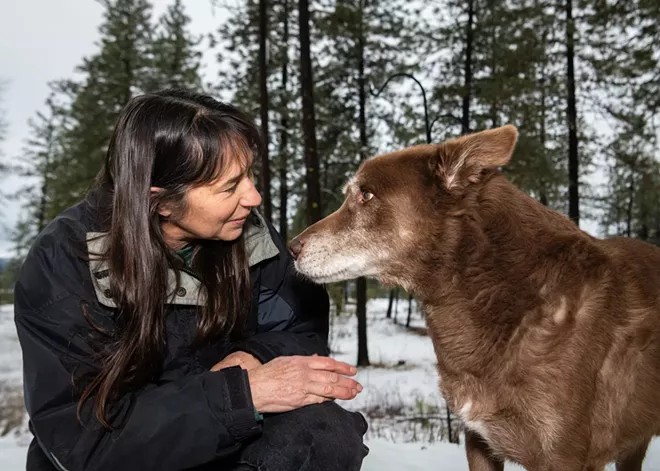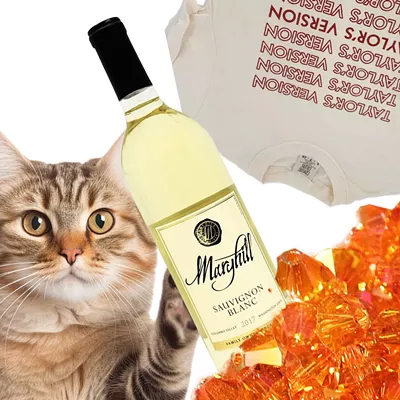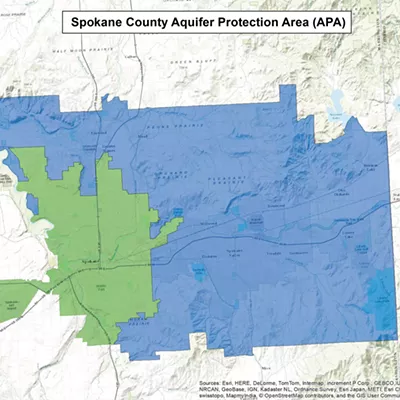It's a classic Hallmark scene: a box under the Christmas tree shakes, then whimpers. A nose sticks out, then two eyes, then a puppy with a big red bow on its collar leaps into loving arms.
But then, the rest of the year comes — often with expensive vet bills or training failures. Unexpected challenges take their toll, and sometimes pets need new homes.
But this year, options for dogs that need homes are narrowing, and large, untrained dogs might be getting left out.
"We have community-wide issues in terms of animal welfare not being controlled very well in our community," says Jeff Sandler, who volunteers with SpokAnimal and Short-Term After Hours Rescue, or STAHR, two pet nonprofits in Spokane.
As 2025 starts, animal welfare advocates are facing a new year of rising costs and tensions. With insurance premiums rising across the country, SpokAnimal and the Spokane Humane Society were forced last year to limit the size of animal or types of behavioral issues they accept in order to afford coverage. The other large animal welfare organization, Spokane County Regional Animal Protection Services, or SCRAPS, is a law enforcement agency that is required first and foremost to prioritize public safety from dangerous animals, not owner surrenders.
Smaller rescues and relocation services like STAHR and Freddie B's Furry Friends Rescue fill in some gaps but have even smaller capacities. It's hard to estimate how many animals are abandoned and uncared for, but for some working in animal welfare, their current workload has them worried about the future.
"The rescues are full. The shelters are full," says Brenda Wright, a volunteer with SpokAnimal and River's Wish Animal Sanctuary, and a board member of Freddie B's Furry Friends Rescue.
"Every time we euthanize a dog [in Spokane], everybody freaks out. But there are places [in the country] that euthanize 100 dogs a day," Wright says. "If people think that's not where we're going to end up, it is where we're going to end up if we don't see some changes."
A BITE FROM INSURANCE
Between rescuing kittens, socializing puppies, saving sick pets and matching animals with new families, one of the last things animal shelter staff want to think about is insurance.But insurance can make or break a shelter. Finding an insurer to cover an animal shelter, which by nature puts staff and volunteers at some risk of dog bites or cat scratches, is much harder than it used to be.
For Spokane Humane Society, dog bites are more than hypothetical. After two volunteers sustained dog bites, the society's insurance premium increased from $40,000 per year to about $240,000 last year, Executive Director Kim Reasoner-Morin says.
"I cannot say a dog bite is not risky, because they happen very, very quickly — we're talking under 10 seconds — and it is life changing for the person that sustains the injury," Reasoner-Morin says. "Those canines that have done that here are sweet. They take treats from you. You go out on walks with them. But one thing is, they're unpredictable. The last thing I want is for any person that I know or don't know to experience that. It's something I take very seriously."
It might be typical for a premium to go up after filing a claim, but going up by five or six times the current amount is unusual and burdensome. Still, Reasoner-Morin says she was determined to stay open so her staff wouldn't lose their jobs, and so other clinical services the Humane Society provides, including spaying and neutering, would remain available to low-income families. There was only one insurer willing to cover the shelter after the dog bites, she says, so she took it.
From an insurer's perspective, everything is more expensive right now, which means paying out for claims and medical bills is more expensive, says Aaron VanTuyl, communications manager for the Washington state Office of the Insurance Commissioner.
Plus, insurance rates lag behind actual costs, VanTuyl says, since companies have to apply for and justify rate increases before actually raising prices. Premiums are playing catch-up with the rest of the economy and therefore can reflect crises from a few years ago.
In October 2023, the Humane Society instituted a behavioral assessment for dogs before accepting them. Reasoner-Morin says that's the best practice for all shelters around the country per the American Society for the Prevention of Cruelty to Animals. The Spokane Humane Society does turn some dogs away, but they still accept more than they deny, she says.
"We do see a lot of individuals that are bringing in their mom's cat or their dad's dog [from a parent] who just passed away," Reasoner-Morin says. "So generally, they're in a home with an older person and they're sweet."
SpokAnimal staff wouldn't speak about their insurance policy, but confirmed they currently only accept dogs that are 30 pounds or less.
SCRAPS, which deals most regularly with dangerous dogs, is insured through the county, which is part of the Washington Counties Risk Pool, according to Pat Bell, communications director for the county.
Though SCRAPS has the fewest insurance worries, it can't provide the same services that SpokAnimal or the Humane Society offer. It's technically a law enforcement agency, not a shelter, and therefore has a different role to play, says Jesse Ferrari, SCRAPS' director.
SCRAPS doesn't accept owner surrenders and has to prioritize aggressive dog complaints, he says. If someone brings in a lost dog that's friendly, SCRAPS will probably suggest taking it back to the neighborhood where it was found and trying to locate the owner privately.
Ferrari calls it a "common sense approach," since chances are good that the dog hasn't wandered far. One day last year, someone brought in a lost dog who was reclaimed by its owner only a half hour later.
"The owner said, 'I know they were trying to do the right thing, but I was nine houses down,'" Ferrari says.
This style of managed intake, sometimes called "community sheltering," is a hot topic in the animal welfare community and critiqued by some STAHR members. They worry that community members may not be able to properly assess how friendly a dog is, might feel uncomfortable re-releasing a lost dog into their neighborhood, or simply be tasked with a job that isn't theirs to do.
"They could bite people, they could carry disease," says Yvonne Leach, who volunteers at SpokAnimal and is certified in Dogs Playing For Life, which helps assess shelter dogs and match them with adopters.
"There's also the whole process of then relying on the community to be the solution when [SCRAPS is] supposed to be providing the care and the solutions to the community," she says.
In 2024, SCRAPS responded to 7,000 requests for service, reunited more than 600 animals with their owners, and adopted out more than 2,550 animals without homes, Ferrari says.
Per its duties as a law enforcement agency, SCRAPS also euthanizes dogs that are deemed dangerous to the public. Ferrari says a team of behavioral specialists goes through the same decentralized decision-making process when evaluating animals so that "every animal gets the same chance."
Local animal advocacy organizations like Underground Rainbow question the reliability of such behavioral evaluations, which are meant to predict whether dogs would be safe to adopt out, and are concerned they result in excess euthanizations.
BREEDING MORE PROBLEMS?
Even if insurance premiums magically decreased or shelters had unlimited funding, it still might not solve the larger issues when it comes to dogs in need."Focusing on insurance is really going the shallow route," Sandler says. "It's much deeper than that."
The issue isn't how to pay for services and coverage, but the number of dogs that need shelters or rescue care every year, he says.
"If there was another shelter built, it would just get full," says Tandi Brayson-Foster, the founder and executive director of STAHR. "That doesn't solve the problem."
Backyard breeding, lack of spaying and neutering, and lack of owner education are major reasons why there are too many dogs and not enough homes, she says.
"This is a national problem, all of these things," Wright says. "People are breeding irresponsibly. They're dumping animals irresponsibly. Just with Freddie's rescue, every single day somebody wants to rehome, or somebody's calling because they found a dog that somebody dumped, or a whole litter of puppies that somebody dumped. There's no place for them to go."
In 2009, when the Washington Legislature put laws in place trying to regulate irresponsible breeding, lawmakers found that "an unfair fiscal burden is placed on city, county, and state taxpayers as well as government agencies and nongovernmental organizations, which are required to care for discarded or abused and neglected dogs from large-scale breeding facilities."
In Spokane County, it's illegal to sell animals in parking lots or on other public property, which is often where unfixed and unvaccinated pets from breeders are sold. In 2023, Washington passed a law restricting pet stores from selling puppy mill puppies in order to crack down on irresponsible breeding.
Still, informal breeding and selling is less regulated just across the border in Idaho. It's common knowledge that people can easily buy a puppy in the parking lot of the Post Falls Cabela's most weeks.
Informal breeding is happening in Washington, too. But as financially and emotionally taxing as it is to deal with animals that end up at shelters, it's even more expensive to find backyard breeders in the first place.
"How much do we want to spend in taxes to shut them down?" says Reasoner-Morin of the Humane Society.
She wonders if anyone knows exactly how many animals in the area are slipping through the cracks. Though she often hears concerns that backyard breeders will create more strays, she's less alarmist about their role in adding to the problem.
"I think it's more based on a feeling versus actual data," she says.
According to the national database Shelter Animals Count, the number of strays in the entire country was around 3.8 million in 2022 and 2023, with about the same number expected for 2024. Their dashboard shows that shelter intakes have decreased, but the number of animals surviving shelters has also decreased — since 2020, there has been a steady increase of animals dying in care or being euthanized.
But the number most on Reasoner-Morin's mind is the recent update from her team that 75% of people who made appointments in the last two weeks to rehome their pets didn't show up. That either means people didn't end up needing to surrender their animal, or that they had a problem getting to the Humane Society. Her team is still trying to figure it out. For Reasoner-Morin, there are a lot of great services for adoption, spaying and neutering, and low-cost medical care available in Spokane — people just need to use them. Just about everyone agrees that awareness, education and more utilization of the services available are keys to creating a better quality of life for both people and pets.
"There's a lot of things going on in Spokane County that need to be addressed," Sandler says. "Rather than blaming a particular shelter for not being able to take in animals, what we wanted to present is an awareness that this is happening and what else is going on in the community." ♦


























